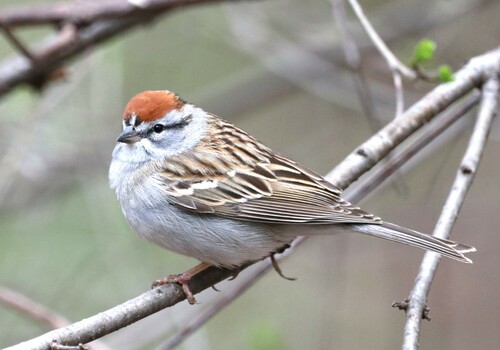
Chipping Sparrow
The Chipping Sparrow (*Spizella passerina*) is a common and widespread North American songbird, known for its distinctive, rapid trill. This small, slender sparrow plays a vital role in seed dispersal and insect control within its diverse habitats. While not particularly flashy in appearance, its persistent song and adaptability have made it a familiar sight in backyards, parks, and open woodlands across the continent. It holds no specific major cultural significance but is appreciated by birdwatchers for its subtle beauty and cheerful presence.
12-15 cm
Length
20-23 cm
Wingspan
Least Concern
Conservation Status
Distribution
Breeds across North America, from Alaska and Canada south to Mexico and parts of Central America. Migratory, with northern populations wintering in the southern United States and Mexico. Altitudinal range extends from sea level to high-elevation forests.
Lifespan
Up to 9 years in the wild, though average lifespan is likely shorter.
Chipping Sparrow's Habitat
Habitat Types
Open woodlands, Forest edges, Parks, Gardens, Grasslands with scattered trees, Savannas
Climate Zones
Temperate, Subtropical, Boreal
Adaptations
Their relatively small size and agility allow them to forage in dense vegetation and on the ground. They are adaptable to a wide range of temperatures and food sources.
Variations
Several subspecies are recognized, differing slightly in plumage and size, particularly between eastern and western populations.
Appearance
Breeding Plumage
Breeding adults have a bright rufous cap, a black line through the eye, and a white supercilium. Non-breeding plumage is duller, with a streaked brown crown.
Seasonal Feather Changes
Significant differences between breeding and non-breeding plumage, as described above.
Sex Based Plumage Differences
Minimal; males may have slightly brighter plumage during breeding season.
Notable Features
Rufous cap (breeding plumage), Black eyeline, White supercilium (eyebrow stripe), Grayish-white underparts
Diet and Feeding
Primary Foods
Seeds, Insects, Small fruits
Foraging Behavior
Forages primarily on the ground, hopping and scratching to find seeds and insects. May also glean insects from foliage.
Specializations
No highly specialized feeding adaptations; generalist diet contributes to its adaptability.
Seasonal Diet Variations
Diet shifts with the seasons. Primarily insects during the breeding season, switching to mostly seeds in the fall and winter.
Behavior
Social Structure
Generally solitary or in pairs during the breeding season. Forms small flocks during migration and winter.
Communication
Distinctive, rapid trilling song (a series of 'chip' notes), Various call notes, including a 'seet' call, Visual displays during courtship and territorial defense
Migration
Northern populations are migratory, traveling south for the winter. Migration is often nocturnal.
Territorial or Group Behaviors
Males defend territories during the breeding season. Outside of breeding, they are generally less territorial.
Conservation
Threats
Habitat loss and degradation, Pesticide use, Collisions with buildings and vehicles, Predation by domestic cats
Protection Programs
Migratory Bird Treaty Act (in the United States), Various habitat conservation initiatives
Local National Laws
Protected under the Migratory Bird Treaty Act in the US and similar legislation in Canada and Mexico.
Population Trend
Stable
Population Estimates
Global population estimated at 160 million individuals.
Interesting Facts
Chipping Sparrows often reuse the same nesting territory year after year.
This indicates site fidelity and the importance of suitable breeding habitat.
They are known to be parasitized by Brown-headed Cowbirds.
Cowbirds lay their eggs in the nests of other birds, leaving the Chipping Sparrows to raise their young.
The Chipping sparrows are ground foragers.
Chipping Sparrows spend a lot of time foraging on the ground.
Faqs about Chipping Sparrow
What is the Chipping Sparrow's song like?
It's a rapid, dry trill, often described as a series of 'chip' notes strung together.
Where can I find a Chipping Sparrow?
Look for them in open woodlands, parks, gardens, and areas with scattered trees and shrubs.
Are Chipping Sparrows aggressive?
Males can be territorial during the breeding season, but they are generally not aggressive towards humans.
Do Chipping Sparrows Mate for Life?
Chipping Sparrows are presumed to be primarily monogamous, but extra-pair copulations are not uncommon.
Copyright @ Nature Style Limited. All Rights Reserved.
 English
English